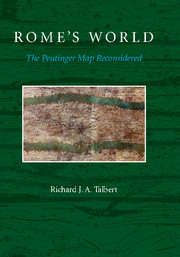Book contents
- Frontmatter
- Contents
- List of Plates, Figures, and Table
- Preface and Acknowledgments
- Abbreviations
- INTRODUCTION
- 1 THE SURVIVING COPY: HISTORY, PUBLICATION, SCHOLARSHIP
- 2 THE SURVIVING COPY: THE MATERIAL OBJECT AND ITS PALEOGRAPHY
- 3 THE DESIGN AND CHARACTER OF THE MAP
- 4 RECOVERY OF THE ORIGINAL MAP FROM THE SURVIVING COPY
- 5 THE ORIGINAL MAP
- CONCLUSION: THE MAP'S PLACE IN CLASSICAL AND MEDIEVAL CARTOGRAPHY
- APPENDIX 1 Latin Text Appended to the 1598 Engraving of the Map
- APPENDIX 2 English Translation of J. Kastelic, “Vodnikova kopija Tabule Peutingeriane” (trans. Gerald Stone)
- APPENDIX 3 Reflections on Vodnik's Copy of von Scheyb's Engraving
- APPENDIX 4 Vodnik's Latin Summary of Heyrenbach's Essay (National Library of Slovenia, Ljubljana, MS 1443)
- APPENDIX 5 Miller's Reconstruction of the Map's Western End
- APPENDIX 6 Wyttenbach's Claim: A Lost Piece of the Map Discovered
- APPENDIX 7 User's Guide to the Database and Commentary
- APPENDIX 8 User's Guide to the Map (A) and Overlaid Layers
- APPENDIX 9 User's Guide to the Outlining of Rivers and Routes on Barrington Atlas Bases (C–F), with Associated Texts: (a) Antonine Itinerary (ItAnt) Text with Journeys Numbered as on Map E, and (b) Bordeaux Itinerary (ItBurd) Text with Journeys Lettered as on Map F
- Notes
- Bibliography
- Index and Gazetteer
4 - RECOVERY OF THE ORIGINAL MAP FROM THE SURVIVING COPY
- Frontmatter
- Contents
- List of Plates, Figures, and Table
- Preface and Acknowledgments
- Abbreviations
- INTRODUCTION
- 1 THE SURVIVING COPY: HISTORY, PUBLICATION, SCHOLARSHIP
- 2 THE SURVIVING COPY: THE MATERIAL OBJECT AND ITS PALEOGRAPHY
- 3 THE DESIGN AND CHARACTER OF THE MAP
- 4 RECOVERY OF THE ORIGINAL MAP FROM THE SURVIVING COPY
- 5 THE ORIGINAL MAP
- CONCLUSION: THE MAP'S PLACE IN CLASSICAL AND MEDIEVAL CARTOGRAPHY
- APPENDIX 1 Latin Text Appended to the 1598 Engraving of the Map
- APPENDIX 2 English Translation of J. Kastelic, “Vodnikova kopija Tabule Peutingeriane” (trans. Gerald Stone)
- APPENDIX 3 Reflections on Vodnik's Copy of von Scheyb's Engraving
- APPENDIX 4 Vodnik's Latin Summary of Heyrenbach's Essay (National Library of Slovenia, Ljubljana, MS 1443)
- APPENDIX 5 Miller's Reconstruction of the Map's Western End
- APPENDIX 6 Wyttenbach's Claim: A Lost Piece of the Map Discovered
- APPENDIX 7 User's Guide to the Database and Commentary
- APPENDIX 8 User's Guide to the Map (A) and Overlaid Layers
- APPENDIX 9 User's Guide to the Outlining of Rivers and Routes on Barrington Atlas Bases (C–F), with Associated Texts: (a) Antonine Itinerary (ItAnt) Text with Journeys Numbered as on Map E, and (b) Bordeaux Itinerary (ItBurd) Text with Journeys Lettered as on Map F
- Notes
- Bibliography
- Index and Gazetteer
Summary
This third and last of the chapters to examine the surviving copy marks a transition to making the lost original map the primary focus of attention. The issue addressed here – of how accurately our copy may be reckoned to reproduce the original – has the greatest importance, but in fact the confidence with which assessments can be offered must vary considerably. If the danger were not already obvious enough by its very nature, Ptolemy himself warns that repeated copying of a map leads to the compounding of errors. Moreover, even for the production of the original, it may be unrealistic to assume that the data was uniformly correct and complete as supplied or marked in the first instance.
Thereafter, omissions, slips, and distortions are all too easily introduced by copyists through oversight or inaccuracy, especially in the case of line work. Copyists are also liable to make deliberate omissions, adjustments, and additions. Where parchment is used – as in the case of our copy – certain adjustments may patently be mere shifts in the placement of names in order to avoid holes or cuts. More generally, however, there will often be no means for copyists' initiatives to be detected once made, let alone reappraised. Some may reflect worthy intentions in the interests of improving and updating the map. Others, by contrast, may at best be decorative licence on the part of copyists keen to embroider it in some way or other, and unconcerned that its integrity might suffer as a result.
- Type
- Chapter
- Information
- Rome's WorldThe Peutinger Map Reconsidered, pp. 123 - 132Publisher: Cambridge University PressPrint publication year: 2010



